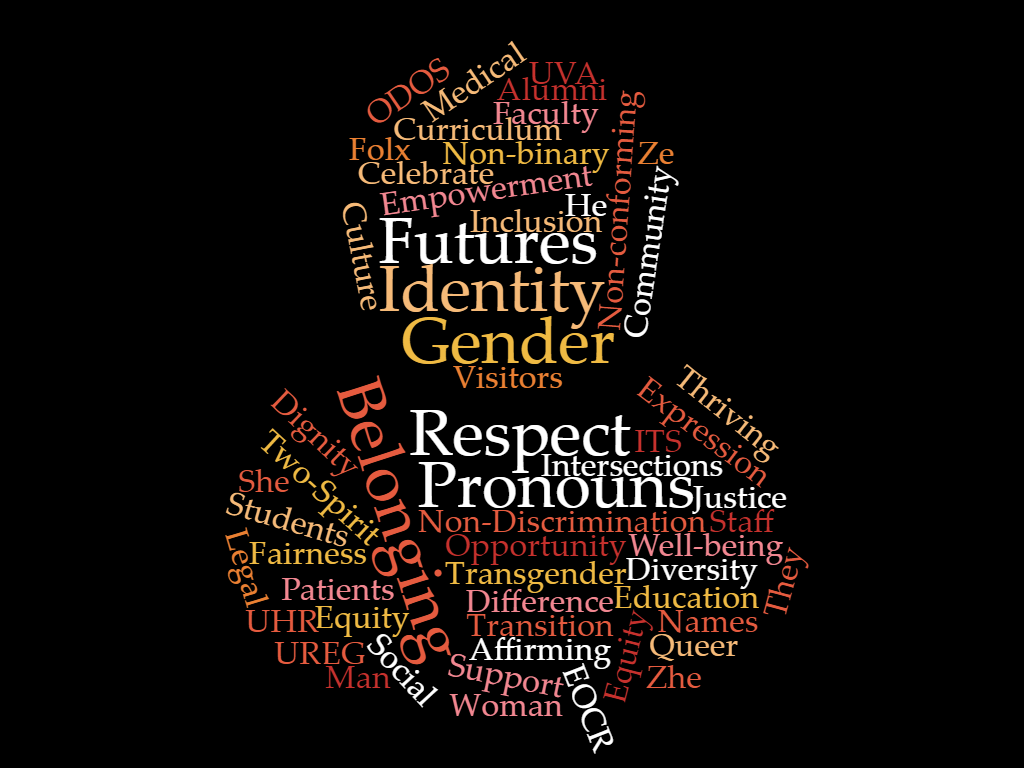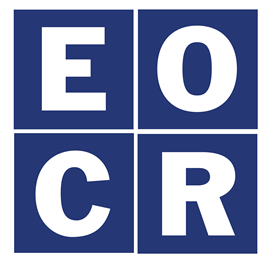
The University of Virginia, including UVA Health and the College at Wise, is deeply proud of the contributions to research, teaching, patient care, service, scholarship, and learning made by our students, faculty, staff, and alumni who are transgender and gender non-conforming (TGNC). UVA is committed to a living, learning, working, and patient care environment that is free from discrimination on the basis of gender identity and gender expression (Notice of Non-Discrimination and Equal Opportunity).
In partnership with a broad range of UVA stakeholders, EOCR has assembled a list of resources, answers to common questions, best practices, and educational information to support a gender affirming and informed community. Many of these resources have been summarized in the "Gender Transition Guide," a link to which is provided below.
By expanding a topic below, you can review key sections of the Gender Transition Guide as well as other educational resources that may be of interest. If you have questions about the guide; University policy relating to sex/gender or gender identity or expression; or another related question, please contact EOCR at UVAEOCR@virginia.edu or (434) 924-3200.
We also encourage you to review the in-depth information about chosen personal pronouns to learn more about their importance to our community and how their use promotes a welcoming climate for gender diversity in our living, learning, working, and patient care environments.
Inclusive Learning Environments
The following are a few recommended guidelines for supporting gender transition or gender nonconformance in the learning environment:
- Do not call the roll or otherwise read the roster aloud until you have given students a chance to share their preferred name.
- Allow students to self-identify their name and invite, but do not require, all in the class to identify their pronouns. Do not make assumptions based on the class roster or the student’s appearance. A great way to accomplish this is to pass around a sign-in sheet with pronoun options.
- If you are aware a student has a former name that they do not use--because you knew them before they changed it, because it is on the roster, or otherwise--do not use it or reveal it to others. Comments like,“I knew Gina when she was Bill,” even if intended to be supportive, reveal deeply personal information about the student and unnecessarily draws attention to their identity.
- Set a tone of respect. At the beginning of each semester when establishing the guidelines for class behavior expectations, include something like: “It is important that this classroom be a respectful environment where everyone can participate comfortably. One part of respectful behavior is that everyone should use preferred names and pronouns. This includes pronouncing people’s names correctly.” Add specific guidelines for respect that you consider important, but make sure to include pronoun usage since individuals are often unaware of the issue.
Inclusive Workplaces
Creating a welcoming and inclusive work environment for TGNC faculty and staff requires fostering an open and collegial working environment long before an individual makes the personal decision to transition. If you are a manager, you are a representative and extension of the University and, therefore, are responsible for compliance with the University’s Notice of Non-Discrimination and Equal Opportunity Statement and associated policies and procedures, which include workplace protections on the basis of gender identity and gender expression, among other identities. A preliminary proactive step you can take as a manager is to attend a Safe Space (Charlottesville| Wise) training as well as schedule one for your entire team. It is important to recognize it is not the responsibility of a TGNC employee to serve as an educator in support of their transition, or in preventing bias, discrimination, harassment, or retaliationin the workplace. Here are a few additional basic tips:
- If you are aware of a faculty/staff member’s former name that they do not use—either because you knew them before they transitioned, because it is on their personnel record, or otherwise—do not use it or reveal it to others. Comments like “I knew Gina when she was Bill,” even if intended to be supportive, reveal deeply personal information about the individual, and unnecessarily draw attention to their identity.
- Set a tone of respectand model the behaviors. One part of respectful behavior is using preferred names and pronouns. This includes pronouncing people’s names correctly.
- Consider modeling behavior around pronoun identification by including those you have chosen to use when you introduce yourself or in your email signature (or including a link to information on why this is important,such as Pronouns Webpage).
- If you are in a situation where you realize that your colleague may not be out as TGNC in all contexts, avoid unintentionally outing them.This could mean refraining from using pronouns.
- Talk to your colleague to learn more about what makes them feel respected and use that information to inform your actions.
- Do not show undue curiosity about someone’s personal life.
Language Is Powerful
When considering the following terminology, remember that:
- Definitions vary across communities and generations; not all TGNC individuals will agree with all of these definitions so please defer to the terms your individual students, faculty, staff, alumni, and patients use to describe themselves.
- This is not intended to be an exhaustive list.
- Terms and definitions change, so this list will be updated on a periodic basis as appropriate to reflect the self-determination of our community.
- Sex/Sex-Assigned-At-Birth (SAAB): An assignment of Male or Female based on physical traits such as genitalia, gonads, chromosomes, and hormones.
- Intersex: Someone whose physical traits do not fit the typical definitions of Male or Female.
- Gender: A social category that associates sex-assigned-at birth with behaviors and social roles, often differentiated as man and woman.
- Gender Identity: A person’s internal experience and naming of their gender.
- Gender Expression: External appearance of one’s gender identity, usually expressed through behavior, clothing, haircut, or voice, and which may or may not conform to what is defined socially as being either masculine or feminine.
- Cisgender (abbreviation: cis): Someone who identifies with their SAAB.
- Transgender (abbreviation: trans): an encompassing term of many gender identities for those who do not identify or exclusively identify with their SAAB.
- Bigender: Someone who identifies with two or more genders all or some of the time.
- Agender: Someone who does not identify with any gender.
- Genderqueer: Someone who does not conform to the conventional binary gender categories of man and woman.
- Genderfluid: Someone whose gender identity fluctuates among genders.
- Two-Spirit: An umbrella term used by some Indigenous peoples to describe their gender, sexual, and spiritual identity. It is a contemporary term that bridges Indigenous and Western understandings of gender and sexuality. There are many definitions and understandings of two-spirit and each is Indigenous-nation specific, marking a connection for Indigenous people to their cultural traditions, which historically have recognized more than two genders.
- Non-binary: An umbrella term describing people who do not exclusively identify on the commonly used gender binary of man or woman.
- Gender Nonconforming/Gender Expansive: Broad term referring to people who do not behave in a way that conforms to the traditional expectations of their gender or whose gender expression does not fit into a socially defined category.
- Transitioning: The social, medical, and/or legal process of aligning one’s life and physical characteristics to match their gender identity.
- Social Transition: The social portion of a transition, in which a transgender individual makes others aware of their gender identity. Some parts of social transition can include informing others as to gender identity, whether or not they are aware of the individual’s assigned sex and/or transgender status. This process may include using a different name, asking people to use different pronouns to refer to the person, changing gender expression, and/or using a different restroom. A social transition is not dependent on medical or legal transition status.
- Legal Transition: A legal transition may involve legal procedures at various levels of government such as changing one’s legal name and/or sex marker on one or more documents (e.g., driver’s license, birth certificate). Aspects of legal transition may be inaccessible to some on the basis of their state of residence or other considerations.
- Medical Transition: A medical transition may involve medical procedures such as hormone therapy and/or surgery to change the outward gender characteristics of one’s body. Medical transition may require some institutional support in relation to providing time off or allowing breaks in academic status for surgeries and medical care in accordance with other policies.
- FTM (female to male): Generally refers to someone assigned female at birth who identifies as male. Someone who identifies as FTM may or may not be in the process of transitioning to male.
- MTF (male to female): Generally refers to someone assigned male at birth who identifies as female. Someone who identifies as MTF may or may not be in the process of transitioning to female.
- Medical Gender Affirmation: Refers to the many varied procedures and processes that a trans individual may undertake to better align their physical body with their gender identity.
- Personal Gender Pronouns: The pronoun or set of pronouns that an individual uses (everyone has these) to describe themselves and that others should use when talking to or about that individual.
- Transition Plan: A collaboratively sourced plan for the actions that will be taken in support of an individual’s gender social transition.
- Queer: A term some people use to identify themselves with a flexible and inclusive view of gender and/or sexuality. It is also seen in academic fields, such as queer studies or queer theory. Historically it has been used as a negative term for LGBTQ people. Some people still find the term offensive while some embrace the term as an identity.
Resources
UVA-Based
- Office for Equal Opportunity & Civil Rights
- The Office of the Dean of Students: Charlottesville | Wise
- UVA Wise Office of Compliance & Inclusion
- LGBTQ Center
- LGBTQ Committee
- The Maxine Platzer Lynn Women’s Center
- Counseling and Psychological Services (CAPS)
- Faculty and Employee Assistance Program (FEAP)
- UVA Student Health
- UVA Health System: Transgender Health
Non-UVA

